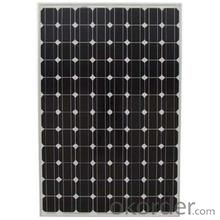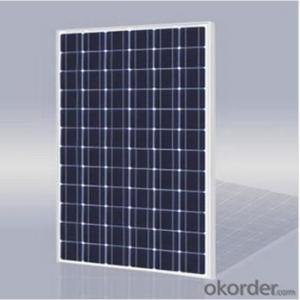CNBM On Grid System 7000W with Certificate UL TUV CE
- Loading Port:
- Shanghai
- Payment Terms:
- TT OR LC
- Min Order Qty:
- 100 watt
- Supply Capability:
- 1000 watt/month
OKorder Service Pledge
OKorder Financial Service
You Might Also Like
Item specifice
CNBM On Grid System 7000W with Certificate UL TUV CE
Product description
They range from small residential and commercial rooftop systems to large utility-scale solar power stations. Unlike stand-alone power systems, a grid-connected system rarely includes an integrated battery solution, as they are still very expensive. When conditions are right, the grid-connected PV system supplies the excess power, beyond consumption by the connected load, to the utility grid.
Connection of the photovoltaic power system can be done only through an interconnection agreement between the consumer and the utility company. The agreement details the various safety standards to be followed during the connection.[4]
Solar energy gathered by photovoltaic solar panels, intended for delivery to a power grid, must be conditioned, or processed for use, by a grid-connected inverter. Fundamentally, an inverter changes the DC input voltage from the PV to AC voltage for the grid. This inverter sits between the solar array and the grid, draws energy from each, and may be a large stand-alone unit or may be a collection of small inverters, each physically attached to individual solar panels. See AC Module. The inverter must monitor grid voltage, waveform, and frequency. One reason for monitoring is if the grid is dead or strays too far out of its nominal specifications, the inverter must not pass along any solar energy. An inverter connected to a malfunctioning power line will automatically disconnect in accordance with safety rules, for example UL1741, which vary by jurisdiction. Another reason for the inverter monitoring the grid is because for normal operation the inverter must synchronize with the grid waveform, and produce a voltage slightly higher than the grid itself, in order for energy to smoothly flow outward from the solar array.
Solar modules use light energy (photons) from the sun to generate electricity through the photovoltaic effect. The majority of modules use wafer-based crystalline silicon cells or thin-film cells based on cadmium telluride or silicon. The structural (load carrying) member of a module can either be the top layer or the back layer. Cells must also be protected from mechanical damage and moisture. Most solar modules are rigid, but semi-flexible ones are available, based on thin-film cells.
Application
Industrial
Commercial
Residential
Feature
Residential, grid-connected rooftop systems which have a capacity more than 10 kilowatts can meet the load of most consumers.[2] They can feed excess power to the grid where it is consumed by other users. The feedback is done through a meter to monitor power transferred. Photovoltaic wattage may be less than average consumption, in which case the consumer will continue to purchase grid energy, but a lesser amount than previously. If photovoltaic wattage substantially exceeds average consumption, the energy produced by the panels will be much in excess of the demand. In this case, the excess power can yield revenue by selling it to the grid. Depending on their agreement with their local grid energy company, the consumer only needs to pay the cost of electricity consumed less the value of electricity generated. This will be a negative number if more electricity is generated than consumed.[3] Additionally, in some cases, cash incentives are paid from the grid operator to the consumer.
Packaging
With carton and box
- Q:How does the angle and orientation of solar panels affect their performance?
- The angle and orientation of solar panels greatly affect their performance. The angle at which the panels are tilted determines how much sunlight they can capture. A panel that is angled towards the sun will receive more direct sunlight, leading to higher energy production. The orientation of the panels, such as facing south in the northern hemisphere or north in the southern hemisphere, also plays a role in maximizing energy output. Properly aligning the panels with the sun's path ensures optimal exposure and improves overall performance.
- Q:Can a solar energy system be used in areas prone to earthquakes?
- Yes, a solar energy system can be used in areas prone to earthquakes. Solar panels are typically designed to withstand various weather conditions, including earthquakes. They are built to meet specific structural standards and are tested for durability. Additionally, solar energy systems do not rely on any intricate moving parts, making them less vulnerable to damage during seismic activities. However, it is important to ensure proper installation and adhere to local building codes to enhance their resilience in earthquake-prone areas.
- Q:Can solar energy systems be used in areas with limited access to solar monitoring systems?
- Yes, solar energy systems can still be used in areas with limited access to solar monitoring systems. While solar monitoring systems provide valuable data about the performance of solar panels and optimize their efficiency, they are not essential for the basic functioning of solar energy systems. Solar panels can still generate electricity from sunlight without constant monitoring. In areas with limited access to solar monitoring systems, periodic maintenance and inspections can be conducted to ensure the proper functioning and performance of the solar energy system.
- Q:Are there any risks of electrical arcing with solar energy systems?
- Yes, there are risks of electrical arcing with solar energy systems. Electrical arcing can occur due to various factors such as faulty wiring, loose connections, or damaged components. This can lead to fires, damage to the system, and potential harm to individuals nearby. Therefore, proper installation, regular maintenance, and adherence to safety guidelines are crucial to minimize the risks of electrical arcing in solar energy systems.
- Q:Can a solar energy system be installed in an area with high wind speeds?
- In areas with high wind speeds, it is possible to install a solar energy system. However, it is necessary to consider certain factors and take precautions during the installation process. To ensure that the solar panels can withstand strong winds, it is important to select panels specifically designed for this purpose and securely anchor them. Additionally, the support structures such as mounting racks or frames should be firmly fastened to ensure stability. Professional installers who have experience working in high wind areas can design and install the system in a manner that prioritizes safety and efficiency. It may also be necessary to adjust the orientation and angle of the solar panels to minimize wind resistance and potential damage. Through careful planning and installation, solar energy systems can be successfully implemented in areas with high wind speeds, effectively harnessing the power of the sun despite challenging environmental conditions.
- Q:Can solar energy systems be used in areas with limited access to solar connectors and cables?
- Yes, solar energy systems can be used in areas with limited access to solar connectors and cables. Off-grid solar systems, such as standalone solar panels combined with battery storage, can be deployed in remote or inaccessible areas without the need for extensive infrastructure. These systems are self-sufficient and can generate and store electricity for use even without a direct connection to the grid. They are an excellent solution for providing renewable energy in areas where traditional electrical infrastructure is limited or non-existent.
- Q:Can solar energy systems be used for powering off-grid oil platforms?
- Yes, solar energy systems can certainly be used for powering off-grid oil platforms. By installing solar panels on the platforms, they can generate electricity to meet the power demands of various operations and equipment. This renewable energy source can reduce the reliance on traditional fossil fuel generators, lower operational costs, and reduce the environmental impact associated with oil drilling.
- Q:What is the role of solar energy systems in reducing energy poverty?
- Solar energy systems play a crucial role in reducing energy poverty by providing affordable and sustainable electricity access to communities without reliable access to the grid. These systems harness the power of the sun to generate clean energy, which can be used for lighting, cooking, and powering appliances. By eliminating the need for costly and polluting fuels like kerosene, solar energy systems offer a more affordable and environmentally friendly alternative. They empower individuals and communities, improving education, healthcare, and economic opportunities, ultimately breaking the cycle of energy poverty.
- Q:What is the role of grounding systems in a solar energy system?
- The role of grounding systems in a solar energy system is to ensure safety and protect the system and its users from electrical faults and lightning strikes. Grounding refers to the connection of electrical equipment and components to the Earth's surface, creating a low-impedance path for electrical faults to flow, thus preventing the buildup of excessive voltages that could pose a risk to people and equipment. In a solar energy system, grounding serves several important purposes. Firstly, it provides protection against electrical shock by redirecting any fault currents into the ground, minimizing the potential for injury. This is crucial as solar panels and inverters are exposed to sunlight and could be touched by people during maintenance or repairs. Secondly, grounding helps to dissipate static electricity that might accumulate in the system, particularly in panels and mounting structures. Static electricity can cause damage to sensitive electronics and may even lead to fires or explosions if not properly controlled. By grounding these components, any static charges are safely discharged into the ground. Moreover, grounding systems play a vital role in safeguarding the solar energy system against lightning strikes. Lightning carries enormous amounts of electrical energy, and without proper grounding, it can cause severe damage to the system. By providing a low-resistance path for lightning to follow, grounding systems channel the electrical energy safely into the ground, protecting the solar panels, inverters, and other equipment from damage. Lastly, grounding systems help to maintain a stable electrical reference point for the system. This is important for accurate monitoring, control, and efficient operation of the solar energy system. Grounding helps to minimize electromagnetic interference (EMI) and noise that can affect the performance of sensitive electronic components, ensuring optimal functioning of the system. In summary, the role of grounding systems in a solar energy system is to ensure safety by protecting against electrical shocks, dissipating static electricity, and safeguarding against lightning strikes. Additionally, grounding systems maintain a stable electrical reference point, promoting efficient operation and reducing the risk of equipment damage.
- Q:Can solar energy systems be used in areas with strict noise regulations?
- Yes, solar energy systems can be used in areas with strict noise regulations. Unlike traditional power generation methods such as diesel generators or wind turbines, solar energy systems operate silently as they convert sunlight into electricity. This makes them an ideal choice for areas with noise restrictions, ensuring compliance with regulations while still harnessing clean and renewable energy.
1. Manufacturer Overview |
|
|---|---|
| Location | |
| Year Established | |
| Annual Output Value | |
| Main Markets | |
| Company Certifications | |
2. Manufacturer Certificates |
|
|---|---|
| a) Certification Name | |
| Range | |
| Reference | |
| Validity Period | |
3. Manufacturer Capability |
|
|---|---|
| a)Trade Capacity | |
| Nearest Port | |
| Export Percentage | |
| No.of Employees in Trade Department | |
| Language Spoken: | |
| b)Factory Information | |
| Factory Size: | |
| No. of Production Lines | |
| Contract Manufacturing | |
| Product Price Range | |
Send your message to us
CNBM On Grid System 7000W with Certificate UL TUV CE
- Loading Port:
- Shanghai
- Payment Terms:
- TT OR LC
- Min Order Qty:
- 100 watt
- Supply Capability:
- 1000 watt/month
OKorder Service Pledge
OKorder Financial Service
Similar products
New products
Hot products
Related keywords





























